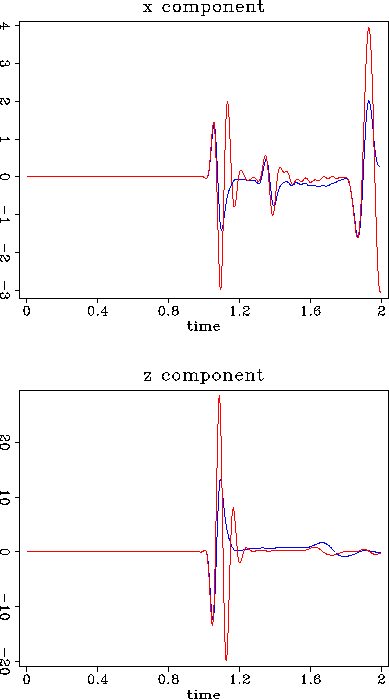




Next: Conclusions
Up: SYNTHETIC EXAMPLES
Previous: Equivalence of modeling equations
Figure ![[*]](http://sepwww.stanford.edu/latex2html/cross_ref_motif.gif) is using the same model as Figures
is using the same model as Figures ![[*]](http://sepwww.stanford.edu/latex2html/cross_ref_motif.gif) and
and
![[*]](http://sepwww.stanford.edu/latex2html/cross_ref_motif.gif) . However, the difference lies in the types of operators used
for calculating the wave field. For derivating the field quantities
a 16 point operator was used, while for derivating the medium parameters
a 6 point wide operator was used. The 16 point operator smoothes the
the propagating wave field more than the 6 point operator. The
short operator is more local and smoothes the medium parameters less.
It does not remove as many high spatial frequencies in the derivation process,
as the longer 16 point operator does. The step discontinuity
really has a very high frequency content and we prefer an
accurate computation of the derivative of that discontinuity.
. However, the difference lies in the types of operators used
for calculating the wave field. For derivating the field quantities
a 16 point operator was used, while for derivating the medium parameters
a 6 point wide operator was used. The 16 point operator smoothes the
the propagating wave field more than the 6 point operator. The
short operator is more local and smoothes the medium parameters less.
It does not remove as many high spatial frequencies in the derivation process,
as the longer 16 point operator does. The step discontinuity
really has a very high frequency content and we prefer an
accurate computation of the derivative of that discontinuity.
long+short
Figure 3 Trace 90 is taken from two wave fields.
The results from the two different modeling equations
are overlain.
The smoother response
is generated by the composite modeling equation with a fixed 16 point
operator. The rougher response is produced by the split modeling equation
, which leaves higher frequencies in the wave field,
if the model itself contains those high frequencies.
The modeling was carried out on a staggered grid.
Again the source is located on top of the step and
the receivers are located below.
On the CD you are able to interactively
experiment with different operator lengths yourself.










Next: Conclusions
Up: SYNTHETIC EXAMPLES
Previous: Equivalence of modeling equations
Stanford Exploration Project
11/17/1997
![[*]](http://sepwww.stanford.edu/latex2html/cross_ref_motif.gif) is using the same model as Figures
is using the same model as Figures ![[*]](http://sepwww.stanford.edu/latex2html/cross_ref_motif.gif) and
and
![[*]](http://sepwww.stanford.edu/latex2html/cross_ref_motif.gif) . However, the difference lies in the types of operators used
for calculating the wave field. For derivating the field quantities
a 16 point operator was used, while for derivating the medium parameters
a 6 point wide operator was used. The 16 point operator smoothes the
the propagating wave field more than the 6 point operator. The
short operator is more local and smoothes the medium parameters less.
It does not remove as many high spatial frequencies in the derivation process,
as the longer 16 point operator does. The step discontinuity
really has a very high frequency content and we prefer an
accurate computation of the derivative of that discontinuity.
. However, the difference lies in the types of operators used
for calculating the wave field. For derivating the field quantities
a 16 point operator was used, while for derivating the medium parameters
a 6 point wide operator was used. The 16 point operator smoothes the
the propagating wave field more than the 6 point operator. The
short operator is more local and smoothes the medium parameters less.
It does not remove as many high spatial frequencies in the derivation process,
as the longer 16 point operator does. The step discontinuity
really has a very high frequency content and we prefer an
accurate computation of the derivative of that discontinuity.
